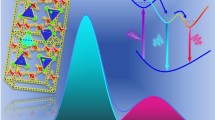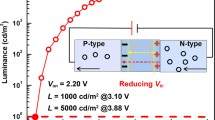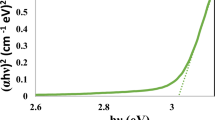Abstract
The temperature dependences of the electrical and electroluminescent properties of InAsSbP/InAsSb/InAsSbP heterostructure LEDs (λ ≈ 3.8−4.0 μm) are studied in the temperature interval 20–200°C. It is shown that the radiation power decreases with increasing temperature in a superexponential manner and that this decrease is associated primarily with a rise in the rate of Auger recombination. The position of the maximum in the radiation spectrum varies with temperature nonmonotonically, since radiative recombination is observed both in the active region and in the wide-gap layer. At room temperature, current through the heterostructure is tunneling current irrespective of the applied voltage polarity. As the temperature rises, either the thermal emission of charge carriers appears (direct bias) or the diffusion current becomes significant (reverse bias).
Similar content being viewed by others
References
T. N. Danilova, B. E. Zhurtanov, A. N. Imenkova, and Yu. P. Yakovlev, Fiz. Tekh. Poluprovodn. (St. Petersburg) 39, 1281 (2005) [Semiconductors 39, 1235 (2005)].
M. Aidaraliev, N. V. Zotova, S. A. Karandashev, B. A. Matveev, M. A. Remennyi, N. M. Stus’, and G. N. Talalakin, Fiz. Tekh. Poluprovodn. (St. Petersburg) 34, 102 (2000) [Semiconductors 34, 104 (2000)].
B. L. Sharma and R. K. Purohit, Semiconductor Heterojunctions (Pergamon, Oxford, 1974; Sov. Radio, Moscow, 1979).
V. V. Pasynkov and L. K. Chirkin, Semiconductor Devices (Vysshaya Shkola, Moscow, 1987) [in Russian].
A. A. Bergh and P. J. Dean, Light Emitting Diodes (Clarendon, Oxford, 1976; Mir, Moscow, 1979).
A. P. Astakhova, A. S. Golovin, N. D. Il’inskaya, K. V. Kalinina, S. S. Kizhaev, O. Yu. Serebrennikova, N. D. Stoyanov, Zs. J. Harvath, and Yu. P. Yakovlev, Fiz. Tekh. Poluprovodn. (St. Petersburg) 44, 278 (2010) [Semiconductors 44, 253 1369 (2010).
M. Aidaraliev, N. V. Zotova, S. A. Karandashev, B. A. Matveev, M. A. Remennyi, N. M. Stus’, and G. N. Talalakin, Fiz. Tekh. Poluprovodn. (St. Petersburg) 35, 1431 (2001) [Semiconductors 35, (2001).
W. J. Duncan, A. S. M. Ali, E. M. Marsh, and P. C. Spurdens, J. Cryst. Growth 143, 155 (1994).
V. N. Abakumov, V. I. Perel, and I. N. Yassievich, Nonradiative Recombination in Semiconductors (PIYaF, St. Petersburg, 1997; North Holland, Amsterdam, 1991).
M. P. Mikhailova, in Handbook Series on Semiconductor Parameters, Ed. by M. Levinshtein, S. Rumyantsev, and M. Shur (World Sci., London, 1999), Vol. 2.
S. J. Adachi, Appl. Phys. 61, 4869 (1987).
M. Aidaraliev, N. V. Zotova, S. A. Karandashev, B. A. Matveev, M. A. Remennyi, N. M. Stus, and G. N. Talalakin, Fiz. Tekh. Poluprovodn. (St. Petersburg) 35, 619 (2001) [Semiconductors 35, 598 (2001).
Author information
Authors and Affiliations
Corresponding author
Additional information
Original Russian Text © A.A. Petukhov, S.S. Kizhaev, S.S. Molchanov, N.D. Stoyanov, Yu.P. Yakovlev, 2012, published in Zhurnal Tekhnicheskoi Fiziki, 2012, Vol. 82, No. 1, pp. 73–76.
Rights and permissions
About this article
Cite this article
Petukhov, A.A., Kizhaev, S.S., Molchanov, S.S. et al. Electrical and electroluminescent properties of InAsSb-Based LEDs (λ = 3.85–3.95 μm) in the temperature interval 20–200°C. Tech. Phys. 57, 69–73 (2012). https://doi.org/10.1134/S1063784212010203
Received:
Published:
Issue Date:
DOI: https://doi.org/10.1134/S1063784212010203




